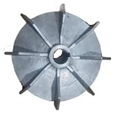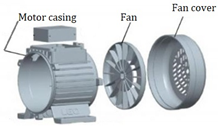Induction motors have gained a renewed interest due to this new shift from conventional power sources to electric power. These motors are known for their high commencing torque, adequate speed control, and reasonable overload capacity. However, induction motors have an innate thermal issue wherein their lifespan and performance are strongly temperature dependent. Hence, it is highly essential to focus on the thermal management aspect of these motors to ensure reliability and enhance performance. This research suggests an integrated approach with two or more cooling strategies and help to serve members of the scientific community, manufacturers or motors users who are interested in the thermal management of induction motors
- lumped parameter thermal networks
- computational fluid dynamics
- thermal analysis
- thermal management
1. Air Cooling Approach
| Fan Design | Axial Fan Performance at 1450 rpm | |||
|---|---|---|---|---|
| Q (m3/s) | Vair (m/s) | Pfan (W) | hair (Pa) | |
| Centrifugal fan, large | - | - | - | - |
| Centrifugal fan, small | - | - | - | - |
| Axial design, A | 0.1151 | 11.3 | 4.7 | 17.3 |
| Axial design, B | 0.1067 | 12.1 | 10.3 | 63.7 |
| Axial design, C | 0.1216 | 12.9 | 11.8 | 70.2 |
| Axial design, D | 0.0998 | 12.5 | 8.0 | 50.7 |
| Various Fan Designs and Covers | Performance of Fan at 1483 rpm | Performance of Motor at 58.08% Load | |||
|---|---|---|---|---|---|
| Vair (m/s) | Pfan (W) | Ploss,total (W) | Efficiency (%) | ΔƟframe (K) | |
| Centrifugal Original Cover, small | 4.4 | 7 | 606 | 87.8 | 19 |
| Centrifugal Original Cover, large | 7.0 | 16 | 615 | 87.6 | 18 |
| Axial design, C, Original Cover | 5.1 | 7 | 600 | 87.9 | 18 |
| Axial design, C, Customized Cover | 5.4 | 9 | 604 | 87.8 | 17 |
| S.No | Fan Type | Fan Configuration | Original Cover | Performance |
|---|---|---|---|---|
| 1 | Small Centrifugal |  |
 |
Applicable for the smaller motor cooling approaches. Efficient cooling for the rotor |
| 2 | Large Centrifugal |  |
 |
Applicable for the bigger motor cooling approaches. Efficient cooling for the rotor |
| 3 | Axial Design, A |  |
 |
Applicable for the moderate motor cooling approaches. Efficient cooling for the rotor, compared to centrifugal type |
| 4 | Axial Design, B |  |
 |
Applicable for the moderate to heavy motor cooling approaches. Efficient cooling for the rotor, compared to Axial design (A) |
| 5 | Axial Design, C |  |
 |
Applicable for the moderate to heavy motor cooling approaches. Efficient cooling for the rotor, compared to all the available designs |


| Ansys Simulated Sections of the Motor | Simulated Temperature, °C (With Out Fan) |
Simulated Temperature, °C (With Both Fans) |
% of Temperature Reduction Due to Fans Both the Sides |
|---|---|---|---|
| Rotor core section (central section) |
324 | 233 | 28 |
| Rotor core section (ends section) |
235 | 202 | 14 |
| Air gap between rotor and stator | 172 | 162 | 5.8 |
| Stator core | 152 | 112 | 23 |
| Housing | 62 | 52 | 16 |
| Air flow passage | 32 | 22 | 31 |
2. Liquid Cooling Approach


| Temperature, °C with 2 Ports |
Temperature, °C with 3 Ports |
Temperature, °C with 3 Ports (Centre Inlet) |
|||||||
|---|---|---|---|---|---|---|---|---|---|
| Number Coolant Passes | 10 lpm | 20 lpm | 30 lpm | 10 lpm | 20 lpm | 30 lpm | 10 lpm | 20 lpm | 30 lpm |
| 4 | 378 | 368 | 364 | 392 | 382 | 375 | 395 | 377 | 371 |
| 6 | 374 | 365 | 362 | 388 | 375 | 370 | 393 | 380 | 374 |
| 8 | 373 | 364 | 360 | 376 | 365 | 363 | 376 | 366 | 363 |
| 10 | 372 | 362 | 359 | 375 | 363 | 360 | 375 | 364 | 361 |
| Number Coolant Passes | Temperature, °C with 2 Ports 30 lpm to 10 lpm |
Temperature, °C with 3 Ports 30 lpm to 10 lpm |
Temperature, °C with 3 Ports (Centre Inlet) 30 lpm to 10 lpm |
Average % of the Variation in Temperature for 30 lpm |
|---|---|---|---|---|
| 4 | 365–380 | 375–395 | 370–395 | 1.3 |
| 6 | 360–375 | 370–385 | 375–395 | 4.1 |
| 8 | 360–375 | 360–375 | 360–375 | 0 |
| 10 | 360–375 | 360–375 | 360–375 | 0 |
| Average % of variation > 4 | Average % of variation > 4 | Average % of variation > 5 |
| Evaluation Method | IM Winding, °C | IM Rotor, °C | Remarks | |||
|---|---|---|---|---|---|---|
| End Part | In Slot | End Part | Core | Shaft | ||
| Analysis | 71.3 | 66.5 | 76.3 | 172.3 | 166 | considering FEM losses |
| Analysis | 77.7 | 72.2 | 83.3 | 185.3 | 179 | considering test losses |
| Test | 75.2 | 65.5 | 80.4 | - | - | - |




3. Heat Pipes/Plates Cooling Approach


| Given Heat LOAD, W | Outer Surface Temperature, °C (with Out Heat Pipes) | Outer Surface Temperature, °C (With Heat Pipes) | % of Variation (Temperature Reduction) | Inner Surface Temperature, °C (with Out Heat Pipes) | Inner Surface Temperature, °C (With Heat Pipes) | % of Variation (Temperature Reduction) |
|---|---|---|---|---|---|---|
| 31 | 42 | 35 | 20 | 48 | 40 | 20 |
| 61 | 58 | 42 | 38 | 70 | 54 | 29.6 |
| 91 | 75 | 52 | 39 | 90 | 68 | 32.3 |
| 119 | 88 | 58 | 51 | 110 | 78 | 41 |
| 149 | 100 | 64 | 56 | 128 | 90 | 42.2 |
This entry is adapted from the peer-reviewed paper 10.3390/en15218127
References
- Roffi, M.; Ferreira, F.J.; De Almeida, A.T. Comparison of different cooling fan designs for electric motors. In Proceedings of the 2017 IEEE International Electric Machines and Drives Conference (IEMDC), Miami, FL, USA, 21–24 May 2017; IEEE: New York, NY, USA; pp. 1–7.
- Moon, S.H.; Jung, Y.H.; Kim, K.W. Numerical investigation on thermal-flow characteristics of a totally enclosed fan cooled IM. In Proceedings of the 2016 XXII International Conference on Electrical Machines (ICEM), Lausanne, Switzerland, 1–4 September 2016; IEEE: New York, NY, USA; pp. 1928–1933.
- Kim, C.; Lee, K.S.; Yook, S.J. Effect of air-gap fans on the cooling of windings in a large-capacity, high-speed IM. Appl. Therm. Eng. 2016, 100, 658–667.
- Zhang, Y.; Ruan, J.; Huang, T.; Yang, X.; Zhu, H.; Yang, G. Calculation of temperature rise in air-cooled IMs through 3-D coupled electromagnetic fluid-dynamical and thermal finite-element analysis. IEEE Trans. Magn. 2012, 48, 1047–1050.
- Kim, C.; Lee, K.S. Thermal nexus model for the thermal characteristic analysis of an open-type air-cooled IM. Appl. Therm. Eng. 2017, 112, 1108–1116.
- Hashish, E. IM Auxiliary Cooling System. United States Patent US 8,912,695, 16 December 2014.
- Rehman, Z.; Seong, K. Three-D numerical thermal analysis of electric motor with cooling jacket. Energies 2018, 11, 92.
- Han, P.W.; Choi, J.H.; Kim, D.J.; Chun, Y.D.; Bang, D.J. Thermal analysis of high-speed IM by using lumped-circuit parameters. J. Electr. Eng. Technol. 2015, 10, 2040–2045.
- Satrústegui, M.; Martinez-Iturralde, M.; Ramos, J.C.; Gonzalez, P.; Astarbe, G.; Elosegui, I. Design criteria for water cooled systems of induction machines. Appl. Therm. Eng. 2017, 114, 1018–1028.
- Le, W.; Lin, M.; Lin, K.; Liu, K.; Jia, L.; Yang, A.; Wang, S. A Novel Stator Cooling Structure for Yokeless and Segmented Armature Axial Flux Machine with Heat Pipe. Energies 2021, 14, 5717.
- Wu, S.; Zhou, J.; Zhang, X.; Yu, J. Design and Research on High Power Density Motor of Integrated Motor Drive System for Electric Vehicles. Energies 2022, 15, 3542.
- Davin, T.; Pellé, J.; Harmand, S.; Yu, R. Experimental study of oil cooling systems for electric motors. Appl. Therm. Eng. 2015, 75, 1–13.
- Rippel, W.E.; Rippel, E.E. Im with Transverse Liquid-Cooled Rotor and Stator. United States Patent US 9,985,500, 29 May 2018.
- Qian, J.Y.; Wu, Z.; Zhang, Q.K.; Jin, Z.J.; Sunden, B.A. Heat transfer analysis on dimple geometries and arrangements in dimple jacketed heat exchanger. Int. J. Numer. Methods Heat Fluid Flow 2019, 29, 2775–2791.
- Pan, M.; Wang, H.; Zhong, Y.; Fang, T.; Zhong, X. Numerical simulation of the fluid flow and heat transfer characteristics of microchannel heat exchangers with different reentrant cavities. Int. J. Numer. Methods Heat Fluid Flow 2019, 29, 4334–4348.
- Fazli, M.; Raisee, M. Computation of flow and heat transfer through channels with periodic dimple/protrusion walls using low-Reynolds number turbulence models. Int. J. Numer. Methods Heat Fluid Flow 2019, 29, 1178–1207.
- Deriszadeh, A.; de Monte, F.; Villani, M.; Di Leonardo, L. Hydrothermal Performance of Ethylene Glycol and Water Mixture in a Spiral Channel for Electric Motor Cooling. In Proceedings of the 2019 21st European Conference on Power Electronics and Applications (EPE’19 ECCE), Genova, Italy, 3–5 September 2019.
- Ijaz, H.; Raza, H.; Gohar, G.A.; Ullah, S.; Akhtar, A.; Imran, M. Effect of graphene oxide doped nano coolant on temperature drop across the tube length and effectiveness of car radiator–A CFD study. Therm. Sci. Eng. Progress 2020, 20, 100689.
- Mukherjee, S.; Halder, T.; Ranjan, S.; Bose, K.; Mishra, P.C.; Chakrabarty, S. Effects of SiO2 nanoparticles addition on performance of commercial engine coolant: Experimental investigation and empirical correlation. Energy 2021, 230, 120913.
- Putra, N.; Ariantara, B. Electric motor thermal management system using L-shaped flat heat pipes. Appl. Therm. Eng. 2017, 126, 1156–1163.
- Gundabattini, E.; Mystkowski, A.; Idzkowski, A.; R., R.S.; Solomon, D.G. Thermal Mapping of a High-Speed Electric Motor Used for Traction Applications and Analysis of Various Cooling Methods—A Review. Energies 2021, 14, 1472.
- Gundabattini, E.; Mystkowski, A. Review of air-cooling strategies, combinations and thermal analysis (experimental and analytical) of a permanent magnet synchronous motor. Proc. Inst. Mech. Eng. Part C J. Mech. Eng. Sci. 2022, 236, 655–668.
- Solomon, D.G.; Greco, A.; Masselli, C.; Gundabattini, E.; Rassiah, R.S.; Kuppan, R. A review on methods to reduce weight and to increase efficiency of electric motors using lightweight materials, novel manufacturing processes, magnetic materials and cooling methods. Ann. De Chim.-Sci. Des Matériaux 2020, 44, 1–14.
- Gundabattini, E.; Mystkowski, A.; Raja Singh, R.; Gnanaraj, S.D. Water cooling, PSG, PCM, Cryogenic cooling strategies and thermal analysis (experimental and analytical) of a Permanent Magnet Synchronous Motor: A review. Sādhanā 2021, 46, 3.
- Boopathi, N.G.; Muthuraman, M.S.; Palka, R.; Wardach, M.; Prajzendanc, P.; Gundabattini, E.; Rassiah, R.S.; Solomon, D.G. Modeling and Simulation of Electric Motors Using Lightweight Materials. Energies 2022, 15, 5183.
